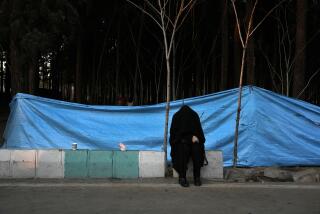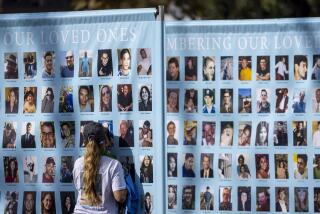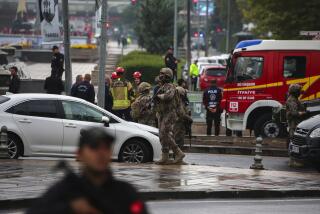Suicide Attacks Rising Rapidly
BAGHDAD — Suicide bombings have surged to become the Iraqi insurgency’s weapon of choice, with a staggering 90 attacks accounting for most of last month’s 750 deaths at the militants’ hands.
Suicide attacks outpaced car bombings almost 2-to-1 in May, according to figures compiled by the U.S. military, The Times and other media outlets. In April, there were 69 suicide attacks, more than in the entire year preceding the June 28, 2004, hand-over of sovereignty.
The frequency of suicide bombings here is unprecedented, exceeding that of Palestinian attacks against Israel and of other militant insurgencies, such as the Chechen rebellion in Russia. Baghdad saw five suicide bombings in a six-hour span Sunday.
Early today, three suicide bombers killed at least 16 Iraqis in blasts north of Baghdad.
The first, around 8 a.m., ripped through a restaurant in Tuz Khurmatu where the Kurdish deputy prime minister, Rosh Shawais, was having breakfast. He was unharmed but a bodyguard was among the nine killed.
In Baqubah, another blast killed the deputy head of the Diyala province governing council, Hussein Alwan Timimi, and four others.
In Kirkuk, a bomber plowed his car into a U.S. consulate convoy. Two Iraqis died and 12 were hurt, a witness said.
With U.S.-led forces now better protected with concrete blast walls and rings of concertina wire and sandbags, militants have taken to targeting Iraqi police and civilians in their bid to convince Iraqis that their new leaders can’t protect them. And increasingly, Iraqis are believed to be carrying out some of the suicide attacks.
U.S. officials and Iraqi analysts say the insurgents’ resources are increasing on several fronts: money to buy vehicles and explosives, expertise in wiring car and human bombs and intelligence leaks that help them target U.S. and Iraqi forces.
Suicide attacks are on the rise because the explosive devices “are simple to construct and easy to operate, thus making suicide bombers difficult to detect,” said Navy Cmdr. Fred Gaghan, in charge of the Combined Explosive Exploitation Cell in Iraq that studies bomb scenes for clues to insurgent tactics.
“They are viewed by terrorists as a successful means with which to kill or injure coalition, Iraqi security forces and innocent Iraqi citizens,” Gaghan said.
“At this time, there is nothing to indicate that the availability of volunteers is on the decline,” he said, noting the media coverage and videos of suicide bombings posted on the Internet that are said to fuel extremist recruitment.
Saad Obeidi, a retired Iraqi major general and security expert, suggested that President Bush had invited Islamic extremists to bring their fight against America here.
“One aim of the U.S. military once it invaded Iraq was to lure all insurgents and terrorists from all over the world to confront them here,” he said.
The first suicide bombings of the insurgency were attributed to foreign infiltrators, mostly Palestinians, Yemenis, Syrians and Saudis. But Obeidi believes that has changed.
“The Iraqi way of thinking in the past totally rejected that someone would kill himself,” Obeidi said. “But once they realized how powerful this weapon is and saw its effectiveness, Iraqis started getting involved in suicide operations.”
Some U.S. officials agree.
“There’s a kind of axiom out there that says Iraqis aren’t suicide bombers,” Gen. George W. Casey, commander of multinational forces in Iraq, told reporters in Baghdad this year. “I’m not sure that’s the case. I believe there are Iraqi Islamic extremists ... that are very capable of getting into cars and blowing themselves up.”
Other U.S. officials say they still believe that foreign fighters are responsible for most of the suicide attacks, which have increasingly targeted Iraqis.
“There is no evidence this is being done by Iraqis,” said U.S. Maj. Gen. John DeFreitas III, intelligence chief for the multinational mission that has about 150,000 troops in Iraq. “In every case we’ve seen, the driver has been a foreigner.”
Coalition officials acknowledge, however, that the numbers show an Iraqi-dominated insurgency. Fewer than 5% of those killed or captured were foreigners, one official noted. He also described the influx from abroad as making up a “very, very small part” of the estimated 12,000 to 20,000 insurgents.
A recent attack in the city of Baqubah points to an Iraqi role in suicide bombings.
On May 15, Imad Shakir, a police major, was inspecting his security unit outside the Baqubah courthouse when he saw an unfamiliar young man in an ill-fitting police uniform approaching.
As the unit’s officers asked the purported first lieutenant for identification, Shakir became suspicious and leaped to seize him. But the impostor detonated his explosives vest, lumpy beneath his blue clothing, killing Shakir and three bystanders.
What set the Baqubah bombing apart from the few others in which survivors got a glimpse of the attacker was that the killer was recognizably Iraqi, said the Diyala province police officer in charge of the investigation.
“The injured people assured us that the suicide attacker was Iraqi. They could tell by the way he talked and from his appearance,” said the officer, who spoke on the condition that he not be identified.
Obeidi, the retired Iraqi general, sees the rise in suicide bombings as recognition among Iraqi extremists that such attacks are an effective weapon against the superior numbers and arms of the coalition forces.
Insurgents “are choosing this method to create a balance against superpower might,” he said. “The use of such methods is linked with some spiritual or religious motives. The aim is to die in the name of religion and become a martyr and go to paradise.”
Maj. Gen. Munem Said Abdulqadir, head of the Iraqi police force explosive ordnance demolition team in Baghdad, faulted the now-disbanded U.S. Coalition Provisional Authority for barring even mid-level figures of Saddam Hussein’s regime from the new security order.
He said he feared there were thousands of technically savvy and disaffected Iraqis, mostly Sunni Arabs, vulnerable to recruitment as suicide bombers.
“Jobless people are very easy targets,” he said of the Iraqis being drawn into bomb-making and suicide missions. “Find them jobs, and most will give up.”
A few would-be suicide bombers survived their attacks or were arrested after their explosives failed to detonate, and Iraqi police have mined those rare intelligence opportunities.
Early this year, Iraqi TV showed footage of a confession from a burned and bandaged Saudi bomber, Ahmed Abdullah Abdul-Rahman Alshai. An Iraqi bomb-maker arrested in January, Sami Mohammed Ali Said Jaaf, reportedly told interrogators that he had a role in orchestrating bombings in Baghdad, including the Aug. 19, 2003, blast at the U.N. mission that killed 22 people.
But insights to the suicide bombers have been few.
“Often with suicide bombers, there’s not enough left of them to be identified,” one senior U.S. military official said. With rare exceptions, the perpetrators wage their final battle in anonymity, traveling to their targets without identity papers to deprive police of any intelligence in the event of their capture.
But some techniques have come to light. The police officer investigating the Baqubah case reported a recent innovation: suicide car bombers cruising the streets with their payloads in search of targets. Witnesses at several car bombings last month told police the drivers appeared to have made last-minute decisions about what to strike.
Other attacks appeared to have taken much more planning.
“They are trying to penetrate defensive measures by conducting more complex attacks, double suicide attacks or suicide attacks combined with other weapons such as small-arms fire or mortar attacks,” said Gaghan, the Navy officer.
In Hillah, south of Baghdad, where two suicide bombers killed dozens at a demonstration Monday, the second bomber followed the fleeing crowd.
At the scene of another recent bombing, police found a foot duct-taped to the car’s accelerator and hands fastened to the steering wheel.
Such restriction, perhaps the result of coercion, would hinder the effectiveness of a suicide strike because the driver would have no control over the detonation, Gaghan noted. Other analysts speculated that the measure wasn’t evidence of forced participation but was taken to ensure that the vehicle reached its target even if the driver was shot while approaching.
But those privy to the bombing investigations say that drivers are sometimes duped into deadly bombings.
“Some who drive car bombs don’t know they are going to blow up. They are told to take a car to a certain location and that they will receive further information afterward,” said Kamil Abdulmajeed, chief judge for the 2nd Iraqi Central Criminal Court. “When they arrive, the car is suddenly detonated by remote control.”
In the bomb-rattled capital, authorities have advised residents to be vigilant for signs of bombers: cars traveling at high speed with a young male driver as the sole occupant, a low-riding chassis, trunks heavily loaded or tilted. At a May 21 defense strategy session with coalition forces, an Iraqi general said cars had been spotted with religious writing on the side to identify them to other suicide drivers. He did not elaborate, according to a U.S. military report on the session.
The suicide bomber’s vehicle of choice has also been consistent. White Volkswagen Passats made in Brazil, which proliferated in the capital during Hussein’s regime because he gave them as presents to the families of those killed in the 1991 Persian Gulf War, were used in at least half a dozen blasts that rattled Baghdad last week.
*
Times staff writers Louise Roug and Jeffrey Fleishman and special correspondents in Kirkuk and Baqubah contributed to this report.
More to Read
Sign up for Essential California
The most important California stories and recommendations in your inbox every morning.
You may occasionally receive promotional content from the Los Angeles Times.











